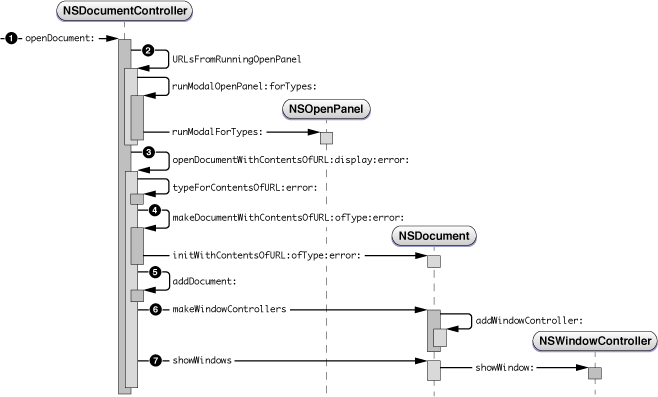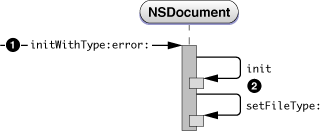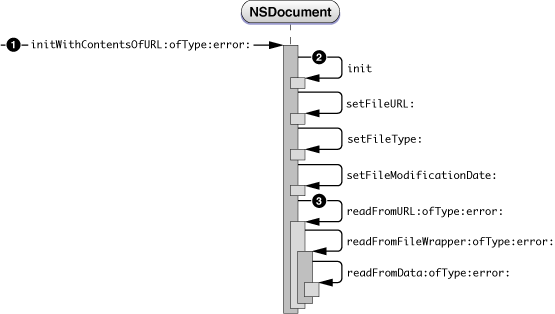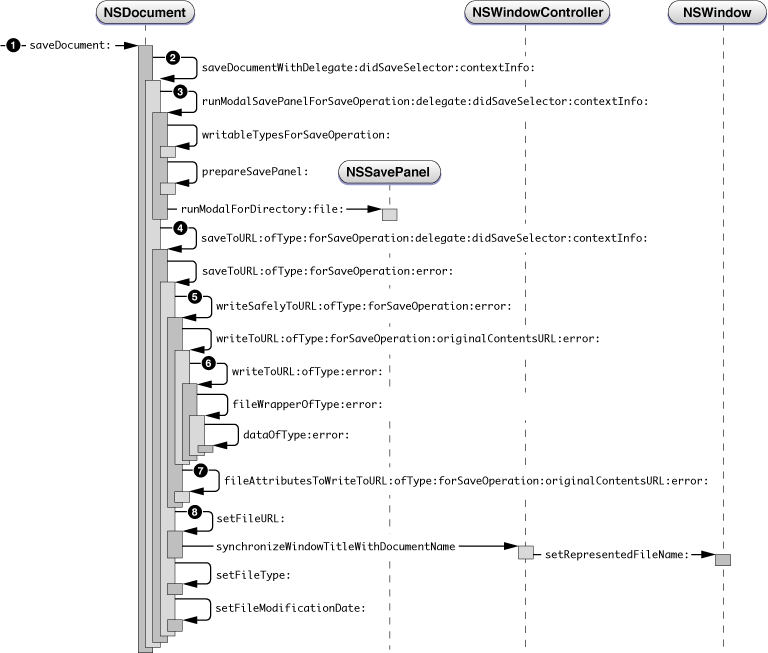Message Flow in the Document Architecture
The objects that form the document architecture interact to perform the activities of document-based applications, and those interactions proceed primarily through messages sent among the objects via public APIs. This provides many opportunities for you to customize the behavior of your application by overriding methods in your NSDocument subclass or other subclasses.
This article describes default message flow among major objects of the document architecture, as defined in Mac OS X v10.4, including objects sending messages to themselves; it leaves out various objects and messages peripheral to the main mechanisms.
This article doesn't cover code paths the document architecture takes to support Java, as well as older, Objective-C document-based applications that override methods deprecated in Mac OS X v10.4. (If those methods are overridden, the document architecture ensures that they are called, so their customizations still work properly. Of course, such applications don't benefit from the improvements introduced in Mac OS X v10.4, such as robust error handling.) Finally, these messages are sent by the default implementations of the methods in question, and the behavior of subclasses may differ.
Contents:
Creating a New Document
Opening a Document
Saving a Document
Creating a New Document
The document architecture creates a new document when the user chooses New from the File menu of a document-based application. This action begins a sequence of messages among the NSDocumentController object, the newly created NSDocument object, and the NSWindowController object, as shown in Figure 2.
The sequence numbers in Figure 2 refer to the following steps in the document-creation process:
The user chooses New from the File menu, causing the
newDocument:message to be sent to the document controller (or an Apple event, for example, sends an equivalent message).The
openUntitledDocumentAndDisplay:error:method determines the default document type (stored in the application'sInfo.plistfile) and sends it with themakeUntitledDocumentOfType:error:message.The
makeUntitledDocumentOfType:error:method determines theNSDocumentsubclass corresponding to the document type, instantiates the document object, and sends it an initialization message.The document controller adds the new document to its document list and, if the first parameter passed with
openUntitledDocumentAndDisplay:error:isYES, sends the document a message to create a window controller for its window, which is stored in its nib file. TheNSDocumentsubclass can overridemakeWindowControllersif it has more than one window.The document adds the newly created window controller to its list of window controllers by sending itself an
addWindowController:message.The document controller sends the document a message to show its windows. In response, the document sends the window controller a
showWindow:message, which makes the window main and key.
If the first parameter passed with openUntitledDocumentAndDisplay:error: is NO, the document controller needs to explicitly send the document makeWindowControllers and showWindows messages to display the document window.
Opening a Document
The document architecture opens a document, reading its contents from a file, when the user chooses Open from the File menu. This action begins a sequence of messages among the NSDocumentController, NSOpenPanel, NSDocument, and NSWindowController objects, as shown in Figure 3.
There are many similarities between the mechanisms for opening a document and creating a new document. In both cases the document controller needs to create and initialize an NSDocument object, using the proper NSDocument subclass corresponding to the document type, the document controller needs to add the document to its document list, and the document needs to create a window controller and tell it to show its window.
Document Opening Message Flow
Opening a document differs from creating a new document in several ways. If document opening was invoked by the user choosing Open from the File menu, the document controller must run an Open panel to allow the user to select a file to provide the contents of the document. An Apple event can invoke a different message sequence. In any case, the document must read its content data from a file and keep track of the file's meta-information, such as its URL, type, and modification date.
The sequence numbers in Figure 3 refer to the following steps in the document-opening process:
The user chooses Open from the File menu, causing the
openDocument:message to be sent to the document controller.The URL locating the document file must be retrieved from the user, so the
NSDocumentControllerobject sends itself theURLsFromRunningOpenPanelmessage. After this method creates the Open panel and sets it up appropriately, the document controller sends itself therunModalOpenPanel:forTypes:message to present the Open panel to the user. TheNSDocumentControllerobject sends therunModalForTypes:message to theNSOpenPanelobject.With the resulting URL, the
NSDocumentControllerobject sends itself theopenDocumentWithContentsOfURL:display:error:message.The
NSDocumentControllerobject sends itself themakeDocumentWithContentsOfURL:ofType:error:message and sends theinitWithContentsOfURL:ofType:error:message to the newly createdNSDocumentobject. This method initializes the document and reads in its contents from the file located at the specified URL. “Document Initialization Message Flow” describes document initialization in this context.When
makeDocumentWithContentsOfURL:ofType:error:returns an initializedNSDocumentobject, theNSDocumentControllerobject adds the document to its document list by sending theaddDocument:message to itself.To display the document's user interface, the document controller sends the
makeWindowControllersmessage to theNSDocumentobject, which creates anNSWindowControllerinstance and adds it to its list using theaddWindowController:message.Finally, the document controller sends the
showWindowsmessage to theNSDocumentobject, which, in turn, sends theshowWindow:message to theNSWindowControllerobject, making the window main and key.If the
URLsFromRunningOpenPanelmethod returned an array with more than one URL, steps 3 through 7 repeat for each URL returned.
Document Initialization Message Flow
Initialization of the NSDocument subclass object is typical. Steps in the document-initialization process for document creation are shown in Figure 4. Document initialization in the context of document opening is noteworthy because it invokes the document's location-based or data-based reading and writing methods, and you must override one of them. Steps in the document-initialization process for document opening are shown in Figure 5.
The sequence numbers in Figure 4 refer to the following steps in the document-initialization process:
The
NSDocumentControllerobject begins document initialization by sending theinitWithType:error:message to the newly createdNSDocumentobject.The
NSDocumentobject sends theinitmessage to itself, invoking its designated initializer, then sets its filetype by sending itself the messagesetFileType:.
The sequence numbers in Figure 5 refer to the following steps in the document-opening process:
The
NSDocumentControllerobject begins document initialization by sending theinitWithContentsOfURL:ofType:error:message to the newly createdNSDocumentobject.The
NSDocumentobject sends theinitmessage to itself, invoking its designated initializer, then sets its metadata about the file it is about to open by sending itself the messagessetFileURL:,setFileType:, andsetFileModificationDate:.The
NSDocumentobject reads the contents of the file by sending thereadFromURL:ofType:error:message to itself. That method gets a file wrapper from disk and reads it by sending thereadFromFileWrapper:ofType:error:message to itself. Finally, theNSDocumentobject puts the file contents into anNSDataobject and sends thereadFromData:ofType:error:message to itself.Your
NSDocumentsubclass must override one of the three document-reading methods (readFromURL:ofType:error:,readFromData:ofType:error:, orreadFromFileWrapper:ofType:error:) or every method that may invokereadFromURL:ofType:error:.
Saving a Document
The document architecture saves a document—writes its contents to a file—when the user chooses one of the Save commands or Export from the File menu. Saving is handled primarily by the document object itself. Steps in the document-saving process are shown in Figure 6.
The sequence numbers in Figure 6 refer to the following steps in the document-saving process:
The user chooses Save from the File menu, causing the
saveDocument:message to be sent to theNSDocumentobject.The
NSDocumentobject sends thesaveDocumentWithDelegate:didSaveSelector:contextInfo:message to itself.If the document has never been saved, or if the user has moved or renamed the document file, then the
NSDocumentobject runs a modal Save panel to get the file location under which to save the document, as it does immediately if the user chooses Save As or Save To from the File menu.To run the Save panel, the
NSDocumentobject sends therunModalSavePanelForSaveOperation:delegate:didSaveSelector:contextInfo:message to itself. The document sendsprepareSavePanel:to itself to give subclasses an opportunity to customize the Save panel, then sendsrunModalForDirectory:file:to the Save panel object.The
NSDocumentobject sends thesaveToURL:ofType:forSaveOperation:delegate:didSaveSelector:contextInfo:and, in turn,saveToURL:ofType:forSaveOperation:error:to itself.The
NSDocumentobject sends thewriteSafelyToURL:ofType:forSaveOperation:error:message to itself. The default implementation either creates a temporary directory in which the document writing should be done, or renames the old on-disk revision of the document, depending on what sort of save operation is being done, whether or not there's already a copy of the document on disk, and the capabilities of the file system to which writing is being done. Then it sends thewriteToURL:ofType:forSaveOperation:originalContentsURL:error:message to the document.To write the document contents to the file, the
NSDocumentobject sends itself thewriteToURL:ofType:error:message, which by default sends the document thefileWrapperOfType:error:message. That method, in turn, sends the document thedataOfType:error:message to create anNSDataobject containing the contents of the document. (For backward compatibility, if the deprecateddataRepresentationOfType:is overridden, the document sends itself that message instead.)The
NSDocumentsubclass must override one of its document-writing methods (dataOfType:error:,writeToURL:ofType:error:,fileWrapperOfType:error:, orwriteToURL:ofType:forSaveOperation:originalContentsURL:error:).The
NSDocumentobject sends thefileAttributesToWriteToURL:ofType:forSaveOperation:originalContentsURL:error:message to itself to get the file attributes, if any, which it writes to the file. The method then moves the just-written file to its final location, or deletes the old on-disk revision of the document, and deletes any temporary directories. In addition, theNSDocumentobject sends thekeepBackupFilemessage to itself. Subclasses can override this method, which returnsNOby default, if they want to retain the backup files created before the document writes its data to the file.The
NSDocumentobject updates its location, file type, and modification date by sending itself the messagessetFileURL:,setFileType:, andsetFileModificationDate:if appropriate.
© 2001, 2009 Apple Inc. All Rights Reserved. (Last updated: 2009-01-12)




